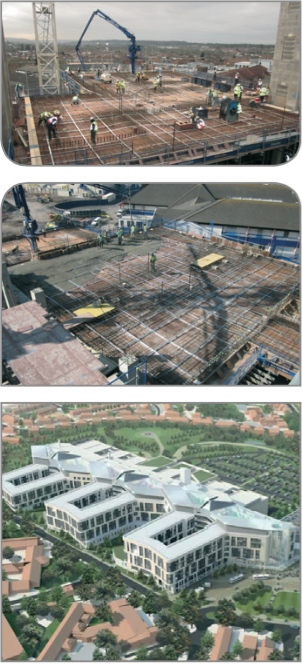 Prestressed concrete
Prestressed concrete
Client
North Bristol NHS Trust
Principal Contractor
Carillion
Frame Contractor
Byrne Bros
Specialist PT Contractor
Freyssinet
Structural Engineer
TPS
Building Services Engineer
DSSR
Value
£900,000
Southmead Hospital was one of Freyssinet’s most significant slab projects. Located in Bristol and owned by the North Bristol NHS Trust, in 2005 the site was chosen for a major re-development and extension of its facilities, with several specialties and services to be centralised in one location.
The £430 million hospital consists of five key zones, one helipad and two car parks. The space is arranged with a spine; to the west of the spine are a series of nine fingers which accommodate the main clinical functions. They are formed by a post-tensioned concrete frame up to seven storeys tall. Abutting the east of the spine are three steel framed ward blocks, being designed to catch as much natural light as possible.
The concrete building is 233m long by 59m wide on average. Two permanent movement joints divide the length into three blocks with the largest being 106m long. The frame is braced by four main concrete cores and several other discrete concrete walls. The cores were slip-formed and the columns precast.
The structural grid varied across the floor space to suit the usage requirements but it reached 9.2m by 9.1m in several locations.
A standard slab thickness of 350mm was adopted across the structure. More substantial steps to accommodate scanners, roof terraces and the like, required a local step in the soffit.
An average floor level was split into nearly 20 pours of typically 225m3 or 650m2 each.
Typical loadings were 4kN/m2 for live load (7.5kN/m2 in plant rooms) plus 1kN/m2 for partitions with an additional 1kN/m2 for superimposed dead load.
The slabs were post-tensioned using the 4B15 bonded flat slab system, with tendons spaced at an average of 1.4m centres in both directions. They were partially stressed the day after the pour in order to part-compress the slab, helping to prevent early age cracking of the concrete. Full stress is applied after the concrete has achieved 25MPa cube strength.
The total area of post-tensioned concrete floor slab was 51,200m2 and the building contains in the order of 300 tonnes of PT.
Construction began in 2010 and the hospital opened its doors in 2014, with completion of the car parking and landscaping in 2015.
